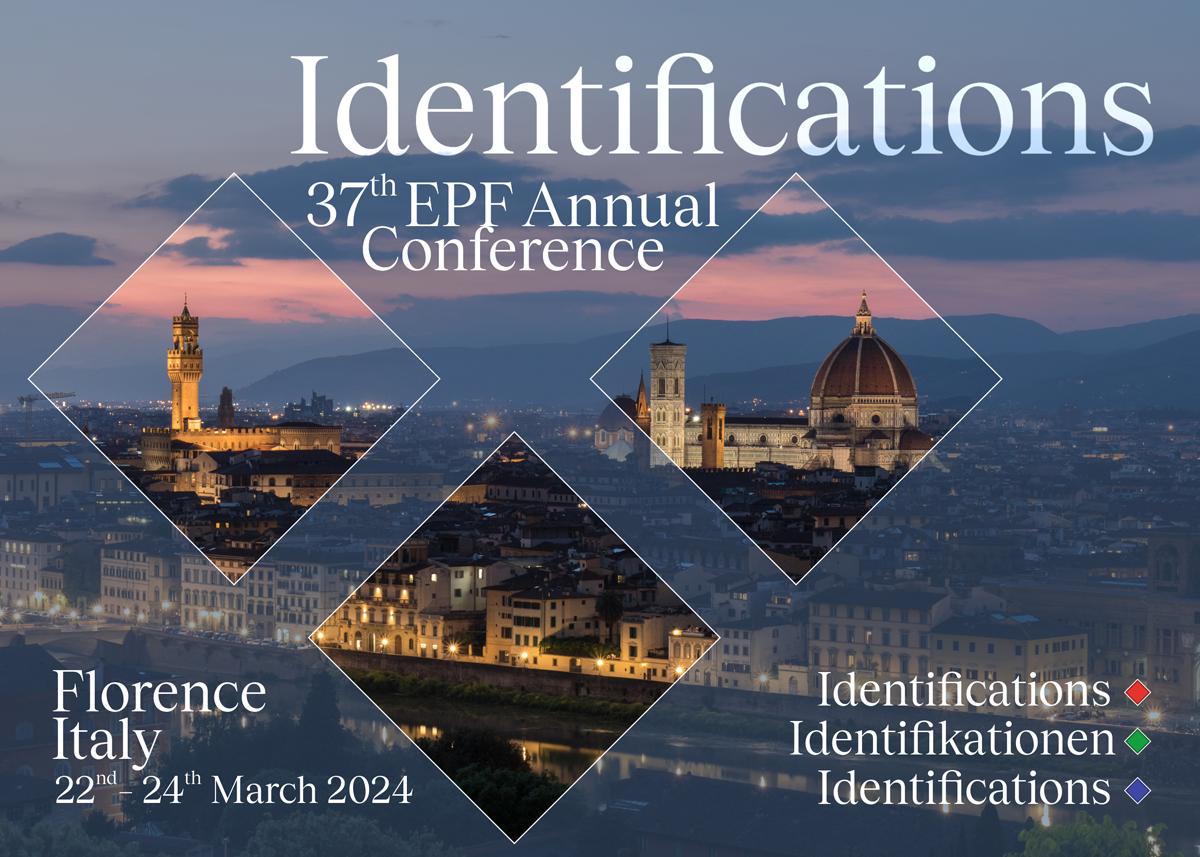22-24/3/2024: Identifications. EPF’s 37th Annual Conference

THE 37th EPF CONFERENCE in Florence, Italy
22nd, 23rd, 24th March 2024
Venue: Firenze Fiera, Centro Congressi, Piazza Adua 1, 50123 Firenze
REGISTRATION IS POSSIBLE FROM NOW ON :
IDENTIFICATIONS
Dear Colleagues
It is with great pleasure that we welcome you to the beautiful and historical city of Florence for the EPF’s 37th Annual Conference on the theme of IDENTIFICATIONS. This theme follows on quite seamlessly from those of the recent EPF conferences – Realities, Ideals and Illusions. It’s striking how in so many of the stimulating plenaries and panels presented during those conferences the term ‘identifications’ frequently arose with a variety of meanings and implications.
The word ‘identification’ is derived from Medieval, later Renaissance Latin as Literary Latin and means the ‘sameness’ or ‘becoming same’ with another object.
The personality is formed through a series of identifications and in ‘The Interpretation of Dreams’ Freud first used the term identifications to refer to a particular process that is characteristic of the dream-work. Hysterical symptoms, such as imitation and mental contagion, were tied in with the hysterical patient’s unconscious identifications: ‘In hysterical phantasies, just as in dreams, it is enough for purposes of identification that the subject should have thoughts of sexual relations without their having taken place in reality’. Strachey, in his editorial note, points out that Freud had already referred to identifications in his correspondence with Fliess in 1897. However, after this reference in ‘The Interpretation of Dreams,’ he did not elaborate further until twenty years later in Chapter 7 of Group Psychology (1921), which was dedicated to an examination of the process of identifications.
Freud outlines three sources of identification: firstly, the original emotional tie with an object; secondly, in a regressive way and by means of introjection of the object into the ego, identification becomes a substitute for a libidinal object-tie; and thirdly, any new perception of a common quality in the object (which is not an object of the sexual instinct). To this third Freud adds, ‘The more important this common quality is, the more successful may this partial identification become, and it may thus represent the beginning of a new tie’. This process is particularly powerful in all groups; political as well as psychoanalytic identifications in and between our societies at an international level. Freud completes Chapter 7 with a notably long footnote indicating the connection between identifications, imitation and empathy. Citing Robertson Smith’s book, ‘Kinship and Marriage’ (1885), Freud comments on the inhibition of aggressiveness towards those with whom one is identified because of the acknowledgement of the possession of a common substance. This feature, he claims, is associated with family identifications as he had addressed in Totem and Taboo (1913).
Psychoanalytic authors, since Freud, have elaborated particularly on the unconscious processes involved in identifications, and a PEP search of the term comes up with over 14,000 entries. ‘Identification with the aggressor’ was not developed by Freud, but rather his daughter, Anna Freud. Sandor Ferenczi also developed the concept but with a different emphasis. For Ferenczi, in his ‘Confusion of Tongues between Adults and the Child’, it is the child’s innocence that is violated by the parental sexual attack that causes the child to ‘introject the guilt feelings of the adult’ (Ferenczi 1933).
Melanie Klein introduced the term ‘projective identification’ in ‘The Psychoanalysis of Children’ (1932), and developed it further when she proposed the notion of a paranoid schizoid position in ‘Notes on some schizoid mechanisms’ (1946). Projective identification was a psychical mechanism emanating from the paranoid-schizoid position and its aim was to injure and control the mother from within. The root of this aim was envy of the object. Klein’s original formulation occurred intrapsychically from birth. Later, Bion developed the notion of a normal projective identification in ‘Learning from Experience’ (1962).
Winnicott follows and elaborates Freud’s differentiation between primary and secondary identifications. When he republished his paper ‘The Use of an Object’, in ‘Playing and Reality’ (1971), he added to the title ‘…and relating through identifications’. Why? Primary identifications were associated with object relating, in Winnicott’s language, the stage of development before the infant is able to put themself into the other’s shoes. While ‘secondary identifications’, refers to the capacity to discern the Other as separate, as he outlines in Chapter 10 (1971) – ‘Interrelating apart from instinctual drive and in terms of cross-identifications’. To move from object relating to object usage was not a given for Winnicott. In fact this move could not occur without the mother’s psychic facilitation. Thus secondary identifications requires an object who will be robust enough to survive in mind and body.
Perhaps Laplanche followed Ferenczi when he questioned Freud’s concept of primary narcissism and proposed that the infant’s narcissistic ideal highlighted the parent’s projected ideal. The ‘primacy of the other’, for Laplanche, meant that the parents ‘assigned’ the infant’s gender. These formulations, as well as all the above, bring us right into the heart of the fraught and controversial clinical issues today concerning gender identifications. Rosine Jozef Perelberg, has recently distinguished between the terms ‘identification’ and ‘identity’ proposing that, especially acting out violent patients, may be ‘overwhelmed between masculine and feminine identificatory processes’ (1999).
How are analysts working today on this central theme in Freud’s work and how do we reflect on the differentiations between primary and Oedipal identifications? What can the psychoanalytic process offer to the individual who is suffering with deeply confusing and conflicting identifications. How are we to comprehend and understand some of the perplexing clinical issues concerning gender identifications? With the theme of identifications we hope that the panels will stimulate further discussion and elaboration. We are very much looking forward to seeing you next year and wish you a very fruitful and enjoyable conference in one of Italy’s most stunning cities.
Heribert Blass President
Jan Abram Vice President Chair Programme Committee
Ewa Glod General Secretary
INDIVIDUAL PAPER SECTION
Call for papers
The EPF Programme Committee invites papers to be submitted for the Individual Paper Section of the 37th EPF conference in Florence 2024 on the theme of IDENTIFICATIONS.
The paper should be between 4,000 and 6,000 words and relate directly to the theme of the conference. Please send your paper in full with the title, author’s name (and short biog.) and the Abstract at the beginning of the paper. Your main argument (up to 250 words), should be outlined in the Abstract. References must also be included at the end of the paper according to the EPF style in the Bulletin. All clinical material must be disguised following the guidelines for the International Journal of Psychoanalysis.
Your submission should be received by November 30th 2023. You will receive the outcome of your submission at the beginning of January 2024.
PLEASE NOTE:
Submissions can only be accepted through the submission system. Please upload your submission here: https://www.eventclass.it/epf2024/
Aims and priorities
The aim of the Individual Paper section is to give new authors an opportunity to write and present a scientific paper at the EPF annual conference. For this reason the work of new authors will be prioritised.
The successful submissions will be presented on Friday 22nd and Saturday 23rd 5.00 pm – 6.30 pm of the conference. (Please note there is a limited number of papers that can be accepted so it is encouraged that you submit your paper well before the deadline).
EPF registration tradition
All participants of the EPF annual conferences are expected to register and pay the appropriate registration fee for the full conference. The only exceptions to this tradition are the Plenary speakers, Executive members and special invited guests for the Round Table and the Film Panel.
All speakers and participants are expected to be IPA members and/or candidates. Guests, who should be recommended by an IPA analyst, are also welcome as long as they are bound by a code of ethics related to psychoanalytical clinical work.
This registration tradition is based on the aims and objectives of the Annual Conferences since the first EPF’s conference in 1976: to offer a forum for European psychoanalysts to gather together for psychoanalytic scientific discourse in an atmosphere of collaboration and tolerance regarding different theoretical psychoanalytic perspectives and the advancement of psychoanalysis.
We trust that all participants will appreciate the spirit of this esteemed tradition and see their registration as a contribution to the continuity and expansion of psychoanalysis in Europe in the best interests of all psychoanalytic societies of the Federation.
Thank you for your consideration.
Registration for the conference in Florence is open now. Fur further information and registration please go to the website of the congress organizer:
 Europäische
Europäische